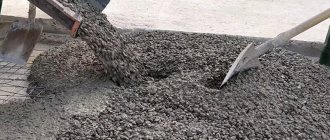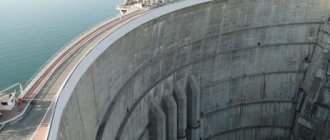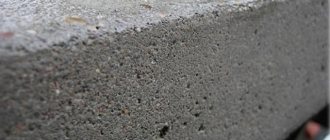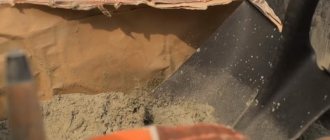BSG concrete (BST, BSM, BSL) are all types of concrete mixtures prepared on the basis of cement, acting as a binder, small and large fillers, as well as water and various additives (used to change the properties of the solution). Knowing the meaning of these abbreviations, you can easily read the markings on the packaging of building materials and find exactly what you need to perform different types of work.
Concrete science
Concrete is a stone building material of artificial origin, which is obtained by preparing and hardening a rationally selected and properly compacted concrete mixture. The mixture always includes a binder (cement), small (sand) and large (crushed stone, gravel, etc.) fillers, plasticizers (special additives to change the characteristics of the monolith) and water.
A ready-to-use homogeneous mixture is called a concrete mixture. This means that all the components have already been taken in the required proportions, mixed correctly according to the technology, and all that remains is to use the solution for its intended purpose. After pouring, compacting, setting and hardening, the mixture turns into concrete.
The full cycle of gaining strength and basic technical characteristics in the case of standard mixtures is 28 days, but this period can be adjusted by additives introduced into the composition.
What types of concrete mixtures are there:
- BST – heavy type (stands for “heavy concrete mixture”)
- BSM – sand concrete (stands for “fine-grained concrete mixture”)
- BSL – light type (“light concrete mixture”)
- BSG – “ready-mixed concrete” refers to all types of mortars that are supplied in already prepared form
BST concrete mix
BST concrete (explained above) is a solution containing heavy components as fillers (most often crushed stone, gravel and others). The density of concrete varies between 1800-2500 kg/m3. The technical characteristics of the material may be different and directly depend on the properties (fraction, type, features) of small and large fillers, as well as their proportions.
When choosing a concrete mixture recipe, craftsmen take into account the requirements for the finished structure, operating conditions, expected loads, etc. All this is considered and indicated at the design stage.
Heavy mixtures differ in grades and strength classes, and can demonstrate different indicators of workability, frost/moisture resistance, etc.
BSG mixture
BSG concrete is any mixture that is ready for use. All solutions that are supplied ready-made (not in the form of a dry mixture, but mixed with water) belong to this type of material. They are usually ordered at a factory, where the mixture is prepared according to technology, then poured into a concrete mixer and delivered to the site.
The master’s task is to quickly use the mixture (within an hour or two), since the shelf life is minimal and after a maximum of two hours the solution begins to set and becomes unsuitable for work. Today, the opportunity to obtain the required volume of concrete solution within the specified time frame is available both in Moscow and in the regions.
BSM mixture
Fine-grained mixture is heavy concrete, which is also called sand concrete. The main feature of BSM is the complete absence of coarse filler (crushed stone, gravel, etc.). At the same time, fine aggregate is introduced into the mixture, which is sand of a fraction of 0.6-5 millimeters. The binder is high-grade cement with a high alite content, which ensures maximum density.
Cement and filler are usually taken in a ratio of 1:2 or 1:3, but sometimes the binder consumption is reduced to a ratio of 1:4 by introducing plasticizers into the composition.
Properties of construction concrete
When choosing concrete, its performance characteristics should be taken into account. Both the ease of working with the mixture and the reliability of future designs depend on them.
Concrete has four main characteristics:
- Strength
- Frost resistance
- Mobility
- Waterproof
Below we will look at each of them in detail.
Strength
This is perhaps the main property of concrete. The higher the strength, the greater the loads the finished structure can withstand and the higher its cost. It is important to find a “golden mean” here. Therefore, before starting construction work, calculations are always made to understand what kind of concrete will be required in a given situation.
Two systems are used to measure strength:
- Brands They are designated by the letter “M” and the following numerical indicator. There are 20 such brands in total - from M50 to M1000. The numbers indicate the load in kg/cm2 that hardened concrete can withstand. To find out the brand of concrete, you need to prepare a solution, let it set, and then wait 28 days until the structure gains full strength. Next, the sample is placed under a hydraulic press and subjected to compression. At some point, under pressure, it collapses. The grade assigned to concrete corresponds to the maximum load that the sample withstood. For example, M150 is 125-175 kg/m2. The disadvantage of this method is that the strength is determined only for a specific sample, and not for the entire structure. And the error here is very high - about 50 kg/cm2. Therefore, professional builders use classes, rather than grades, to indicate the strength of concrete.
- Classes The strength class is indicated by the letter “B” and a number. The number is the pressure in megapascals that concrete can withstand in 95% of tests. In other words, class B30 concrete will not collapse under pressure up to 30 MPa. Strength classes are more accurate than grades. In general, stamps were used exclusively to record test results in the laboratory. That is, this is a statistical indicator. However, in private construction, the strength of concrete is measured in grades. The thing is that without a hydraulic press you will not be able to accurately determine the class of concrete. But the brand can be predicted if you know what kind of cement will be used in the solution.
It looks like this:
| Cement used | Proposed grade of concrete |
| M300 | M100 |
| M300-M400 | M150 |
| M400-M500 | M200-M300 |
| M400-M600 | M400 |
| M500-M600 | M500 |
Moreover, knowing the expected grade of concrete, you can roughly determine the strength class:
| Proposed grade of concrete | Most appropriate concrete class |
| M50 | B3.5 |
| M100 | B7.5 |
| M150 | AT 10 |
| M200 | B15 |
| M250 | IN 20 |
| M300 | B22.5 |
| M350 | B27.5 |
| M400 | B30 |
| M450 | B35 |
| M500 | B40 |
| M600 | B45 |
| M700 | B50 |
| M750 | B55 |
| M800 | B60 |
| M850 | B65 |
| M900 | B70 |
| M950 | B75 |
| M1000 | B80 |
It works like this: let’s say we need to prepare concrete with a strength of B22.5. We know that the M300 brand corresponds to this class. To obtain it, you will need M400 cement (or better yet, M500). If we use high-quality aggregates and select the correct proportions of the components, we will obtain concrete that is closest to class B22.5. If you order a ready-made concrete solution, then in its name the manufacturer usually indicates both the class and the strength grade.
Frost resistance
This parameter indicates the number of freezing and thawing cycles that concrete can withstand without losing its original characteristics. Frost resistance is mainly important for structures that are in direct contact with moisture and soil.
This indicator is designated by the letter F and a number (which corresponds to the number of cycles). To determine frost resistance, concrete samples are placed in freezers for 3 hours. They are then removed and heated to a temperature of +20°C. After another 3 hours, the concrete is frozen again. Sooner or later the sample begins to collapse. The number of freeze/thaw cycles that it could withstand is indicated in the brand name. There are 11 such brands in total - from F25 to F1000.
For example, F300 concrete can withstand up to 300 freezing and thawing cycles. This is a very good indicator. In private construction, grades F50-F300 are usually used. For more demanding work, grades F400-F600 are used. Higher frost resistance is required only for complex engineering structures.
At first glance, it may seem that the number in the brand name is equal to the number of years during which the concrete will retain its strength. But this is not entirely true. You need to understand that in our climate, frosts and thaws can occur 3-4 times a year. Therefore, there is no strict correlation between the brand and the longevity of concrete.
But there is a relationship between strength class and frost resistance:
| Concrete class | Frost resistance grade |
| From B7.5 to B10 | F50 |
| From B15 to B20 | F100 |
| From B22.5 to B27.5 | F200 |
| B30 | F300 |
As you can see, the less durable the concrete, the lower the frost resistance grade it has.
Mobility
This parameter has a second name – workability. It is directly affected by the proportions of the mixture components. The higher the water content in the solution, the more plastic it turns out. It is convenient to work with such material. However, an excess of water leads to a significant reduction in the strength of the future structure.
On the other hand, if there is not enough water and a large amount of cement, the mixture will be too thick. It will stick to shovels and buckets and will not compact well. If air voids remain inside the solution, this will also reduce the strength of the concrete.
Determining mobility is quite simple. To do this, you need to pour the solution into a cone 30 centimeters high and compact it well. After this, the cone is removed, and the concrete begins to spread under its own weight. Depending on how much its shape has changed, the sample is assigned a workability grade.
| Concrete grade | Cone draft (cm) |
| P1 | From 1 to 4 |
| P2 | From 5 to 10 |
| P3 | From 11 to 15 |
| P4 | From 16 to 20 |
| P5 | From 21 to 25 |
It is most convenient to work with grades P2-P4. This type of concrete is easy to lay and compacts well. Grade P5 has very high fluidity. It is not suitable for demanding work. If, after removing the cone, the solution does not sag even a centimeter, it is classified as a hard type. When pouring such concrete, you need to use vibrators, otherwise there will be voids in it.
Application area
Heavy concrete (HCC) is used everywhere - in the construction of various types of buildings, industrial facilities, hydraulic structures, when performing repair work, pouring structural elements, and laying road surfaces. Concrete mortar can have very different characteristics and properties (it all depends on the components and proportions), therefore it is considered a universal building material.
Fine-grained concrete mixture is used in the production of thin-walled structures, for laying road surfaces, and in the production of paving slabs. Most often, this type of mortar is chosen for plastering, facing, and masonry work. Often a rough screed is performed.
BSM is also relevant for the production of reinforced products - where coarse filler simply will not fit between steel rods. Due to the high mobility of the material, the mixture is used to fill various types of construction joints and repair cracks.
BSL is a relatively new material with reduced weight due to its constituent components or foaming agents. Structures made from lightweight concrete are of high quality, with high heat/sound insulation properties. In construction, it is possible to reduce the total weight of the building and the load on the foundation, which is important for the construction of both private houses and multi-story buildings.
What is concrete mix?
Concrete mixture is used to build durable and strong structures. The main composition includes a binder component, water and filler in varying proportions. Additionally, various additives can be used. Based on this, the purpose and properties of the finished product are regulated.
Figure 1. Concrete mix
Brands of ready-mix concrete
Do not confuse concrete brands and types. Manufacturers, as a rule, indicate full labeling in their catalogs or price lists. That is, they do not just write “BSG B15 concrete,” the decoding of which gives only one strength indicator. They can write, for example, “concrete M350 B 25 P4 F200 W8,” but here indicators such as its strength, frost resistance, mobility and even water permeability are already presented.
This is not a publicity stunt. There is a GOST, concrete mixtures BSG of heavy concrete B15, light or even special purpose must be fully marked. In this case, M is the grade of the material, P is its mobility, F is frost resistance, and W is water resistance. At the same time, B is class, and this is not the same as a brand.
This can be seen with an example. M200 or M350 are just average values of compressive strength (a special press is even used to determine them).
Theoretically, the more cement there is in the mixture, the stronger the concrete will be. Therefore, the numbers that are indicated after the letter M indicate how much cement is contained in concrete. Accordingly, it is believed that grades M50-M100 are concretes with a low cement content. Then there are mixtures with an average indicator. Finally, grades M500-M600 have the highest cement content. Their strength is higher, and so is their price.
In a simplified form, we can say that the grade of concrete is its rounded average compressive strength, expressed in kgm/sq.cm. And the class is guaranteed strength in megapascals.
For example, an offer comes by email: “Concrete BSG V15 P3 NKShch.” This will mean that the guaranteed strength is 15 mPa. If we convert it into units of average compressive strength, we get 153. That is, it roughly corresponds to the M150 or even M200 grade.
Previously, concrete was only marked. Now only the class should be reflected in regulatory documents, but many sellers continue to indicate the brand or write both.
Areas of application of structural concrete
The main use of lightweight concrete of all types is in house building and the construction of inhabited industrial facilities. The low density of materials and low weight ensure a reduction in the total weight of building structures and corresponding stability. The high thermal insulation qualities of concrete make it possible to reduce the consumption of more expensive and scarce natural materials.
Blocks and slabs of structural and thermal insulating concrete are used for laying internal partitions and insulating floors and ceilings. A new type of house building has received promising development: cast monolithic walls with reinforcement and reinforced concrete supporting elements.
invites construction organizations and private developers to cooperation in Moscow and the Moscow region. We guarantee: compliance with specified characteristics, exact volume and timely delivery to the site. Leave a request on the website using the on-line order form or contact us by phone. When filling out an application, you must indicate the desired delivery time, the availability of access roads to the facility, and the need for specialized equipment.
Waterproof
The durability of the material is affected not only by its frost resistance, but also by its water resistance. This indicator is of particular importance for concrete, which is used for constructing foundations and pouring foundations in the ground. It is designated by the Latin letter W and reflects the water pressure that concrete can withstand.
Those who buy dry mixtures are no less interested in this indicator. Moreover, they still have to prepare concrete on site.
Those who buy BSG B20 W20 concrete do not need a recipe: the mixture is delivered ready-made, all that remains is to use it within 2 hours so that it does not lose its properties.
What does it represent?
When you need BSG concrete, the decoding of which indicates that it is a ready-made mixture, the customer needs to contact the manufacturer directly. In such cases, the company delivers the mixture using concrete mixer trucks. This is a technique equipped with appropriate equipment that allows you to maintain the solution in a certain state until it arrives at the site.
The composition of BSG is a mixture of classical ingredients - cement, sand, crushed stone, water. The proportions depend on what characteristics the final product should have. BSG may also contain special additives to improve the performance characteristics of the material.
The interpretation of BSG concrete means that the mixture is already ready, and the customer cannot control the process of its production. However, this does not mean that everything is left to chance. The entire production process is still controlled.
The company uses a recipe that meets GOST requirements for such mixtures. Concrete is made from high-quality raw materials, the ingredients are taken in precise proportions, which allows you to obtain a mixture with the specified characteristics, that is, its viscosity will meet the standards, and after hardening the mixture will turn into a monolith that can withstand all standard loads.
What is the difference between mortar and concrete?
Despite the wide selection of all kinds of building materials, concrete and cement mortar are often used in construction. You need to understand the difference between cement and concrete in order to use these materials correctly. They have different structure and purpose. Mixtures are produced at production plants for use in the construction industry.
Concrete and cement are materials that are used for different purposes and have different compositions.
Main advantages
BSG are used in various fields, both for the construction of residential buildings and for industrial construction. Of course, there are some brands of concrete that have specific characteristics and cannot be produced using such technologies, but in general, BSG is a fairly broad category of materials.
The explanation of BSG concrete turns out to be quite long. It is often called ready-mixed concrete. The main advantage is high quality. It is almost impossible to achieve such characteristics on a construction site. After all, to do this, you need to ensure the protection of all ingredients and fillers from contamination, stably maintain the set temperature, and achieve precise adherence to the dosage for each ingredient.
All of these are very difficult tasks. Not to mention the fact that you need to select high-quality basic ingredients from the very beginning and mix them in a certain sequence.
Several criteria are used to classify ready-mixed concrete. They are divided into groups depending on the aggregate used, the density of the cement, the structure of the material, as well as its strength.
From this point of view, there are:
- lightweight concrete;
- BSG concrete mixtures of heavy concrete, and they can be both ordinary and especially heavy;
- ready-made concrete for social purposes.
The choice of a specific variety depends on what tasks are set by the developer.
Where are different grades of concrete used?
When choosing a brand of concrete, be it ready-mixed or dry mix, adhere to the following rules:
- M100 is a material that can be used to prepare the base for road surfaces, to fix curbs, and to construct a base when pouring a concrete foundation.
- M150 is also most often used to form a preparatory layer when constructing monolithic foundations. It can also be an independent foundation, but only for relatively small buildings. It is also used for garden paths in areas.
- M200 is a more popular option, which is most often used when constructing full-fledged foundations of various types - not only strip foundations, designed for a relatively small load, but also monolithic or pile foundations. It is used for screeding where high loads are placed on the floor. Also necessary for the construction of ramps and stairs. Very popular in private low-rise construction.
- The M250 has a similar scope of application, but is used much less frequently. But it is indispensable when constructing high-strength monolithic foundations.
- M300 is a brand that is used in construction for a variety of purposes. It is needed for the production of reinforced concrete slabs, ready-made flights of stairs, it is used for the construction of concrete fences, etc.
- M350 - already higher strength. This mixture is suitable even for floor slabs that can withstand significant loads.
Bridge structures are made of M400 concrete. M500 concrete is also found on the market. But this is very high strength. The material is rarely used in housing construction - it is mainly used in the construction of dams, the construction of bank vaults, etc.
Composition and properties
All concrete mixtures contain cement, water and solid filler. The first material is necessary to bind grains of sand, gravel, crushed stone or boulders together. Liquid is needed to activate the chemical process. And the mineral component is responsible for the strength characteristics of the solution. To enhance certain properties, the use of additional additives is allowed.
The marking of the binder refers to the load (in kg/sq.cm.) that the cube can withstand after the mass has hardened (28 days). So, for the production of concrete, the following cement is used:
- M300 or B22.5 (for solution M100 and M150). It is used to construct an auxiliary layer under the foundation.
- M400 or B32.5 (M200-M400). The production of road surfaces and the construction of low-rise buildings are relevant.
- M500 or B42.5 (M200-M500). It is permissible to cast the foundation.
- M600 or B52.5 (M400-M500). With such a binder, the concrete mixture is used for large-scale construction.
Figure 3. Types of concrete mixtures
The table shows the mass of cement per cubic meter of popular grades of concrete (in kg).











